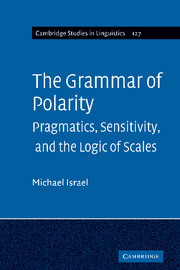Book contents
- Frontmatter
- Contents
- List of figures
- List of tables
- Acknowledgments
- List of abbreviations
- 1 Trivium pursuits
- 2 Ex nihilo: the grammar of polarity
- 3 Licensing and the logic of scalar models
- 4 Sensitivity as inherent scalar semantics
- 5 The elements of sensitivity
- 6 The scalar lexicon
- 7 The family of English indefinite polarity items
- 8 Polarity and the architecture of grammar
- 9 The pragmatics of polarity licensing
- 10 Visions and revisions
- Appendix: A catalogue of English polarity items
- Notes
- References
- General index
- Person index
Appendix: A catalogue of English polarity items
Published online by Cambridge University Press: 07 September 2011
- Frontmatter
- Contents
- List of figures
- List of tables
- Acknowledgments
- List of abbreviations
- 1 Trivium pursuits
- 2 Ex nihilo: the grammar of polarity
- 3 Licensing and the logic of scalar models
- 4 Sensitivity as inherent scalar semantics
- 5 The elements of sensitivity
- 6 The scalar lexicon
- 7 The family of English indefinite polarity items
- 8 Polarity and the architecture of grammar
- 9 The pragmatics of polarity licensing
- 10 Visions and revisions
- Appendix: A catalogue of English polarity items
- Notes
- References
- General index
- Person index
Summary
This is a partial catalogue of words and constructions I suspect may be polarity sensitive in at least some varieties of Modern English. Although this is by no means an exhaustive list, I have sought to include examples of as many different sorts of English sensitive constructions as possible.
The constructions are divided into four groups based on the interaction of the two features, q-value and i-value, as elaborated in §4. The four groups are here named after their most salient exemplars:
any-type NPIs: low quantitative value in a strongly informative proposition, <−q/+i>
some-type PPIs: low quantitative value in a weakly informative proposition, <−q/−i>
much-type NPIs: high quantitative value in a weakly informative proposition, <+q/−i>
galore-type PPIs:high quantitative value in a strongly informative proposition, <+q/+i>
The following conventions are observed here. Different constructions are separated by “;”. Paradigmatic alternatives within a construction are listed in curly brackets and separated by slashes, as {A/B/C}. Simple parentheses are used for constituents within a construction which are either optional or which allow various morphological realizations.
- Type
- Chapter
- Information
- The Grammar of PolarityPragmatics, Sensitivity, and the Logic of Scales, pp. 258 - 266Publisher: Cambridge University PressPrint publication year: 2011



